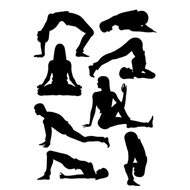- Raja yoga
- Yoga Stretches
- Jivamukti Yoga Poses
- Yoga Tree Pose
- Sun and Moon Yoga
- Wind Removing Pose
- Hare Pose
- Accomplished Pose
- Urdhva Mukha Pinch Mayurasana
- Revolved Abdomen Pose
- Raised Foot Pose
- Scorpion Pose
- Butterfly Pose
- Half Tortoise Pose
- Revolved Twist
- Balancing Stick Pose
- Cat Pose
- Supported Shoulderstand
- Crane Pose
- Handstand
- Happy Baby Pose
- Firefly Pose
- Scale Pose
- Side Plank Pose
- Upward Facing Two-Foot Staff Pose
- Reclining Big Toe Pose
- Stick Pose
- Revolved Head-to-Knee Pose
- Full Boat Pose
- Upward Extended Feet Pose
- Yoga arm balance poses
- Core Yoga
- Inversion Yoga Poses
- Seated And Twist Yoga
- Horse Pose
- Cobbler Pose
- Seated Wide Angle Pose
- Half Crow Pose
- Bound Half Moon Pose
- Lotus Pose
- Reverse Warrior Pose
- Fixed Firm Pose
- Back-bend Poses
- Forward bend Poses
- Sarvangasana
- Ashtanga Yoga Poses
- Warm up poses
- Seated Poses
- Seated Forward Bends
- Chair Poses
- Standing Poses
- Standing Balancing poses
- Yoga Asanas
- Hatha Yoga Asanas
- Yoga Postures Online
- Partner Yoga Poses
- Anusara Yoga Poses
- Advanced Yoga poses
- Restorative Yoga Poses
- Kids Yoga Poses
- Beginning Yoga Postures
The Compass Pose
The Compass Pose is one of the many seated poses in yoga. Yoga is an ancient form of wellness that originated in India.
The concept behind the poses and breathing exercises of yoga was to develop a harmony between the mind, body, and spirit so as to keep all illnesses at bay and lead a healthy and fruitful life.
The Compass Pose is known as Parivrtta Surya Yantrasana in Sanskrit. ‘Parivrtta’ means ‘turned or revolved’, ‘surya’ is ‘sun’, and ‘yantra’ means ‘instrument’. The Compass Pose is a challenging pose as it stretches out the hamstrings and opens up the shoulders. It is typically performed only by advanced practitioners as it is a very complex pose. Furthermore, the Compass Pose should be performed with patience and reverence. A good warm up of hamstrings, hips, groin, shoulders and spine is essential to prepare for the pose. The Compass Pose is used to open up the hips. .
Steps
The Compass Pose steps are as follows:
- Sit comfortably in a cross legged position.
- Bend the right knee and hold it close to the chest.
- Keep the left leg outstretched or bent on the floor.
- Lift the right leg with the left hand and entwine the right hand below the right knee and place the right fingertips on the floor.
- Lift the right knee on to the right shoulder as high up as possible. The higher the leg is lifted, the easier will be the pose.
- Place the left hand on the outside edge of the right foot.
- Try to straighten the right leg and simultaneously bring the left arm behind the head.
- Keep the eyes fixed on the left arm.
- Hold the pose for 10 to 30 seconds.
- Repeat on the other side.
The Compass Pose is an advanced pose and requires a lot of length in the hamstrings, so try to go only as far as you are comfortable. If you’re not successful the first time, do not worry. Regular practice will make you better at it.
Precautions
- Avoid performing this pose in case of shoulder, groin, hamstring or back injury.
- Practice the pose only under guidance to avoid injury.
Beginner's Tip
As mentioned earlier, the Compass Pose is an advanced pose and requires a good amount of strength and flexibility. A good beginner’s tip is to always precede the pose with good warm-up exercises like the Surya Namaskar (Sun Salutation). Additionally, when performing the pose bend your knees or use a yoga strap for support. Also remember not to slump. It is very important to stay up on the top of the sitting bones. Breathing properly will help you maintain control and balance yourself throughout the pose.
Benefit to Body Parts
The Compass Pose has several health benefits. Some of them are as follows:
- Stretches out the hamstrings, groin, shoulders, and spine.
- Opens up and loosens the hips.
- Reinvigorates the kidneys, stimulates the liver, and works the spine.
- Activates digestion and cleanses the organs.
- Nourishes the lower back and limbs.
- Proper execution of the pose stretches the tissues of the lung meridian, which may be beneficial to the respiratory system.
- Improves muscle flexibility.
Therapeutic Applications
Some of the pose’s therapeutic applications, related to the body parts it affects, are as follows:
- Compass Pose works the spine and keeps it elastic and flexible.
- The Compass Pose promotes hip and leg flexibility.
- The Compass Pose helps in detoxification of the body and helps relieve constipation and other minor digestive problems.
- The Compass Pose revitalizes the kidneys and propels them to function better.
- Regular practice of the posture helps develop patience, sensitivity, stability and the sense of accomplishment.
Variations
The variations of the Compass Pose are primarily to make the pose either easier for the practitioner to perform or to make it a little more difficult and challenging. Listed below are some of the common variations.
- You can also perform the Compass Pose while standing up. You will first need to start with the Mountain Pose (Tadasana). Thereafter, you will need to lift your left leg up and towards your side, while keeping your knees straight, but relaxed. Your arms wrap around your leg from around your back to hold your leg up vertically, pointing toward the ceiling. Your body weight is on your right leg. This is a more challenging variation to the Compass Pose.
- An easier variation to the Compass Pose does not require you to lift your leg at all. Once seated with your right leg stretched in front of you and toes pointing upwards, pull your left leg inwards and bend your knee. Pull your leg in towards your groin and align it with your right thigh. The foot of your left leg should be flat on the ground. Next, bend forward slowly, and as you do, move your hands behind you and clasp your fingers. Your left hand should move over your knee, such that your left knee is on the outside of you armpit. Stay in this position for a while, and repeat the routine with the other leg.
Preparatory Poses
Some preparatory poses for the Compass Pose are as follows:
- Standing Forward Bend (Uttanasana)
- Half Spinal Twist (Ardha Matsyendrasana)
- Head to Knee Forward Bend (Janu Sirasana)
- Wide Legged Forward Bend (Prasarita Padottanasana)
Follow up Poses
- Revolved head to knee forward bend (Parivrtta Janu Sirsasana)
Yoga is best practiced with a relaxed state of mind. If the body feels uncomfortable and tired, stop the practice immediately. Moreover, one should not stress the body beyond a certain point. It is best to perfect the preparatory poses first and then try the more advanced ones. Additionally, in case of any ailment or injury make sure that you take the advice of a doctor. Moreover, it is best to carry out the difficult and challenging poses under the guidance of a yoga teacher to avoid mishaps and injuries.
 Find Pose
Find Pose

